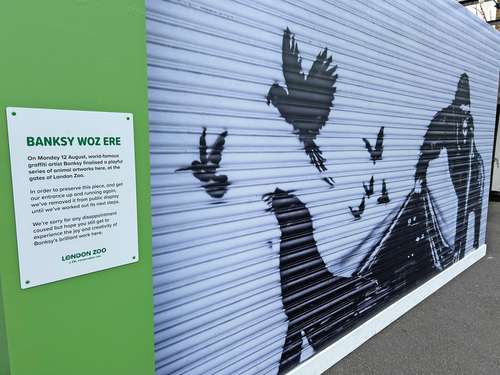London. The gorilla and other animals that appeared to have escaped from London Zoo in Banksy’s latest work are now in safekeeping.
The venue said it removed the graffiti artist’s mural from its entrance on Friday night in order to preserve it and make its entrance fully operational again after crowds of visitors flocked to see it last week.
The entrance was covered with a reproduction of the work and the notice in British slang: Banksy woz ere
(Banksy was here
).
We are thrilled by the joy it has brought to so many people, but most of all, we are incredibly grateful to Banksy for putting wildlife in the spotlight.
Kathryn England, the zoo’s director of operations, said on its website. This has become an important moment in our history, which we wish to preserve properly.
.
The stencil showed an ape lifting part of a metal roller shutter, revealing birds and a sea lion as three pairs of eyes peered out from the darkness inside. It was the artist’s latest animal-themed work to appear for nine consecutive days in London.
The meaning of the graffiti by the graffiti artist known for making political statements has been widely debated online.
The zoo said its mural had sparked thought-provoking conversations among people ranging from a five-year-old to Banksy fans. Some suggested it was a protest piece or a comment on the role of zoos.
A representative for Banksy, whose real identity is unknown, told the Observer that the series was intended to be uplifting and funny in difficult times.
The zoo mural is at least the fifth in a series of animals to be stolen, defaced or moved to a safe place for protection.
A howling wolf painted on a satellite dish to make its silhouette appear to be in front of a full moon was stolen by masked men hours after the artist confirmed it was his work by posting photos of it on his Instagram page. A crew of workers removed a damaged billboard showing a huge cat stretching out, while they were booed by onlookers.
The owner of the advert told police it would be re-installed in an art gallery, the BBC reported.
A rhino painted on a brick wall that appeared to be riding on a broken-down car parked on the sidewalk was sprayed with graffiti and the car was taken away.
The City of London has finally removed a small police guard post that had a circular school of piranhas painted on its windows to make it look like a fish tank. A city government spokesman said it will be placed where the public can see it.
Commentary on human nature
Jasper Tordoff, the Banksy expert at MyArtBroker, told AP that he liked the idea that the final mural in the series was the revelation that all those other animals – elephants, a goat, monkeys and pelicans – seen in London came from the zoo.
But he also said that Banksy, well aware of the attention any of his stencils receives, could have anticipated the public’s reaction.
He could also be making a comment on our human nature to want to own things, even if it means breaking the law.
Tordoff stressed. But we must also try to take care of these pieces and preserve them.
.
The zoo, which protected the mural when it was on display behind a clear plastic shield and guarded by security officers, has not announced what it will do with the work.
However, its removal means the graffiti is preserved, as are the animals themselves. If it goes on display again, it may be inside the zoo, where it can be seen but not touched.
Buchanan o Gunningham
Banksy is the pseudonym of a street artist whose true identity remains hidden, although some speculate that he could be Neil Buchanan, presenter of the television show Banksy. Art Attack, or Robin Gunningham, born on July 28, 1973 in Yate, a town very close to Bristol, the most common theory.
He first became involved with graffiti around the 1980s, with the rise of aerosol. His work, mostly satirical pieces on politics, pop culture, morality and ethnicity, combines writing with graffiti, stencils and templates.
Among his most famous works is Love is in the Air (Flower Thrower)from 2003, which first appeared as large-format graffiti in Bethlehem, shortly after the construction of the West Bank Wall.
